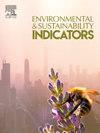Air pollution and environmental tax: Exploring the dynamics in developed nations
IF 5.6
Q1 ENVIRONMENTAL SCIENCES
引用次数: 0
Abstract
Air pollution, particularly fine particulate matter (PM2.5), remains a serious concern in developed countries due to its adverse effects on health and the environment. Environmental taxation has emerged as a key policy tool to curb pollution and encourage cleaner practices. This study investigates the heterogeneous distribution of PM2.5 exposure across 39 developed countries from 1995 to 2020, focusing on environmental taxation, renewable energy consumption, per capita GDP, forest cover, and demographic structure. The study uses the Method of Moments Quantile Regression (MMQR) to assess differential impacts across the pollution distribution. A sensitivity analysis was carried out on sub-samples of low- and high-pollution countries to examine sample heterogeneity. For long-run relationships and causality, the study employs the Cross-Sectionally Augmented Autoregressive Distributed Lag (CS-ARDL) model and the Dumitrescu-Hurlin panel causality test, both accounting for cross-sectional dependence and parameter heterogeneity. Results consistently show that environmental taxation significantly reduces PM2.5 pollution across all quantiles, with stronger effects in cleaner environments (e.g., −0.146 at Q5 vs. −0.106 at Q95). Renewable energy consumption exhibits a stable and robust negative association with pollution levels (−0.164 across quantiles), while forest cover also contributes positively to air quality. In low-pollution countries, short-run dynamics confirm the significant role of environmental taxes (−0.136), and both long-run relationships and causality with PM2.5 are established. These findings highlight the varying effectiveness of environmental policies under different pollution conditions and underscore the importance of fiscal tools, renewable energy adoption, and forest conservation in addressing air pollution in developed economies.
空气污染与环境税:探讨发达国家的动态
空气污染,特别是细颗粒物(PM2.5),由于其对健康和环境的不利影响,仍然是发达国家严重关切的问题。环境税已成为遏制污染和鼓励更清洁做法的关键政策工具。本研究调查了1995年至2020年39个发达国家PM2.5暴露的异质性分布,重点关注环境税收、可再生能源消费、人均GDP、森林覆盖和人口结构。该研究使用矩分位数回归方法(MMQR)来评估污染分布的差异影响。对低污染和高污染国家的子样本进行敏感性分析,以检验样本异质性。对于长期关系和因果关系,本研究采用了横截面增强自回归分布滞后(CS-ARDL)模型和dumitrescui - hurlin面板因果检验,均考虑了横截面依赖性和参数异质性。结果一致表明,环境税显著降低了所有分位数的PM2.5污染,在更清洁的环境中效果更强(例如,第5季度为- 0.146,第95季度为- 0.106)。可再生能源消费与污染水平呈稳定而强劲的负相关(各分位数为- 0.164),而森林覆盖也对空气质量有积极贡献。在低污染国家,短期动态证实了环境税的显著作用(- 0.136),并建立了与PM2.5的长期关系和因果关系。这些发现强调了环境政策在不同污染条件下的不同有效性,并强调了财政工具、可再生能源采用和森林保护在解决发达经济体空气污染问题中的重要性。
本文章由计算机程序翻译,如有差异,请以英文原文为准。
求助全文
约1分钟内获得全文
求助全文
来源期刊

Environmental and Sustainability Indicators
Environmental Science-Environmental Science (miscellaneous)
CiteScore
7.80
自引率
2.30%
发文量
49
审稿时长
57 days
 求助内容:
求助内容: 应助结果提醒方式:
应助结果提醒方式:


